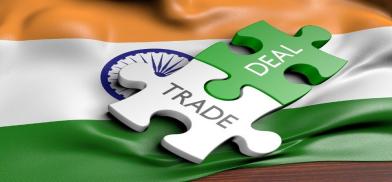Can India emerge as an alternate supply chain to global industries?
Essentially the world is looking for alternate supply chains which began with the onset of the COVID-19 pandemic and continues even today with growing trade tensions between the two camps.

Today, there is yet no conclusive evidence that international trade is deglobalizing. Trade is merely reallocated, not reduced. The tariff war between major trading nations – US and China - did not stop other countries—such as members of the African Union, the Association of Southeast Asian Nations, and the Comprehensive and Progressive Agreement for Trans-Pacific Partnership—from pursuing their regional or plurilateral trade agreements.
The COVID-19 pandemic made many countries temporarily restrict exports of medicines, and a few stopped shipments of wheat and other food items as prices spiked following the Russia- Ukraine war in February 2022. But many governments continue to aggressively pursue economic integration, through agreements that make it easier for professionals to work in foreign countries or facilitate the flow of consumer goods. As Russia cut gas supplies to European nations and energy prices rose, the weakness of relying on a single source for imports of a critical input became clear. But the larger question arose as countries began to wonder what would happen if they had to decouple from China amid the United States imposing a ban on exports to China of advanced logic and memory chips and the machinery to produce them. Semiconductor technologies do have multiple defence and civil applications. The world shifted from one in which trade, competition, and innovation in all countries were encouraged to one in which the most advanced economy sought not just to compete but to restrict competition .[i]
Importance of trade agreements
Over the years trade agreements between countries and regional blocks have expanded economic links between regions. Bilateral trade has grown as a result of numerous bilateral free trade agreements (FTAs) . The FTA process in East Asia has been spurred by European and North American economic regionalism. The 1997–98 Asian financial crisis made it clear that East and Southeast Asian economies in particular needed to work together in the area of trade and investment to address issues of growth and stability by looking at the common challenges the region faced. However, at the global level trade talks have largely focused on liberalization in two key areas—agriculture and non-agricultural market access(NAMA). In essence, developed countries were being asked to reduce agricultural tariffs and subsidies, and developing countries to reduce tariffs for industrial goods, faster and further. Much of the increase in FTA activity can be traced to five of East Asia’s richer and larger economies—Singapore, Japan, Korea, PRC, and Thailand—suggesting a link between FTA growth and economic prosperity. For instance, these five economies had between themselves more than 80 percent of the FTAs in effect in East Asia in early 2009. The most developed country of the region –Japan- implemented bilateral economic partnership agreements (EPAs) with Singapore, Mexico, Malaysia, Chile, Philippines, Thailand, Brunei Darussalam, and Indonesia. In addition, Japan signed FTAs with Vietnam and Switzerland and implemented a comprehensive agreement with ASEAN, which has been even more aggressive. While enacting FTAs with China and South Korea, ASEAN signed an FTA with Australia and New Zealand. The challenge for the countries has been to balance the regional and bilateral approach with the all-encompassing global WTO liberalization framework. With certain exceptions, the region’s poorer economies (notably, Cambodia, Lao PDR, Vietnam, Philippines, and Indonesia) have initially tended to rely on ASEAN for concluding FTAs with the region’s larger economies. This may reflect weak institutional capacity, resources, and leverage to undertakeFTA negotiations by the poorer economies. Evidence provided by surveys conducted by ADB found that most firms in the region see more benefits than costs from the trade agreements. Those benefits include wider market access and preferential tariffs that make it easier to import intermediate materials needed for manufacturing finished goods. The main impediments for non-use include a lack of information on FTAs, low margins of preference, and use of other schemes (such as export processing zones and the Information Technology Agreement) for exporters) and non-tariff measures in partner countries. [ii]
Issue of Concern
An issue of concern arises out of integrating women in international trade. Developed countries including Canada have an opportunity to focus on the issue through General Preferential Tariff (GPT) and Least Developed Countries Tariff (LDCT). least developed countries (LDCs) which could lose zero tariffs if they graduated from the middle-income group. Bangladesh and Nepal are no longer considered the least developed countries. Several other countries have graduated from lower middle-income status to upper middle-income status. If Canada follows international practice (it doesn’t have to), these graduations would imply very high tariffs on exports from many developing countries and they could remove eligibility for zero-tariff treatment from other countries. Canadian tariff is mostly open to developing countries’ exports, exceptions being for four areas: tariffs on supply-managed products, dairy and poultry; random tariffs that protect specific industries; and high average tariffs (17 per cent) on goods from labor-intensive industries like textiles, apparel and footwear (TAF). Exports from the women-staffed TAF sector are often among the highest-value exports from developing countries to Canada. Exporting countries range from Bangladesh, Nepal, and Sri Lanka. Cambodia and Vietnam, the least developed countries of Bangladesh, Nepal, and Cambodia are eligible for zero tariffs as are Peru and Vietnam because of free trade agreements. However, exports from many other countries, e.g., Guatemala, Sri Lanka, Tunisia, South Africa and Lebanon are subject to duties as high as 17 per cent. Bangladesh, Nepal and Laos and Cambodia are about to graduate from the zero tariffs of the LDCT regime.In many countries, around 60-80 per cent of the workforce in TAF industries is female. If tariffs are high, producers are likely to depress wages and working conditions to remain competitive in export markets. Consumers in Canada have benefited from a 2003 preferential scheme for least-developed countries that dropped tariffs to zero and substantially increased imports of TAF items from some LDCs.
By 2017, Bangladesh and Cambodia (which is not yet up for graduation) cut into China’s dominance of the apparel market. These countries substantially increased their market share to an estimated 21 per cent of Asian apparel exports to Canada. If the proposed preferential tariff is anything higher than zero, it will have incremental costs to consumers and producers. Apparel exports from Pakistan, Egypt and Sri Lanka to Canada are a small fraction of Bangladesh’s market share. Further, most exporting countries and SMEs develop industrial clusters by evolving along the TAF spectrum to footwear, headwear and other spin-offs. Non-apparel TAF goods appear to be excluded from the proposed preferential tariff and that exclusion could mean additional costs.[iii]
De-coupling or de-risking
The trade war between the USA and China has been the centre of action for both pro-US and pro -Chinese camps across the world. The trade war continues today and the terms de-coupling and de-risking have gained currency. Essentially the world is looking for alternate supply chains which began with the onset of the COVID-19 pandemic and continues even today with growing trade tensions between the two camps. In this backdrop and keeping in view India's vision of becoming 'Atmanirbhar',(self-reliant and becoming an alternate supply base ) Production-linked Incentive (PLI) Schemes for 14 key sectors have been announced with an outlay of Rs. 1.97 lakh crore (over US$26 billion) to enhance India's Manufacturing capabilities and Exports.
The 14 sectors are (i) Mobile Manufacturing and Specified Electronic Components, (ii) Critical Key Starting Materials/Drug Intermediaries & Active Pharmaceutical Ingredients, (iii) Manufacturing of Medical Devices (iv) Automobiles and Auto Components, (v) Pharmaceuticals Drugs, (vi) Specialty Steel, (vii) Telecom & Networking Products, (viii) Electronic/Technology Products, (ix) White Goods (ACs and LEDs), (x) Food Products, (xi) Textile Products: MMF segment and technical textiles, (xii) High efficiency solar PV modules, (xiii) Advanced Chemistry Cell (ACC) Battery, and (xiv) Drones and Drone Components. The purpose of the PLI Schemes is to attract investments in key sectors and cutting-edge technology; ensure efficiency and bring economies of size and scale in the manufacturing sector and make Indian companies and manufacturers globally competitive. These schemes have the potential to significantly boost production, employment and economic growth over the next five years or so. The concerned Ministries/Departments have notified PLI Schemes for all 14 Sectors after due approval. These Schemes are in various stages of implementation by the implementing Ministries/ Departments. The PLI scheme is expected to have a cascading effect on the country's MSME ecosystem. The anchor units that will be built in every sector are likely to set a new supplier/vendor base in the entire value chain. Most of these ancillary units are expected to be built in the MSME sector. Out of the 733 applications selected under various PLI Schemes, 176 MSMEs are among the PLI beneficiaries in sectors such as Bulk Drugs, Medical Devices, Pharma, Telecom, White Goods, Food Processing, Textiles & Drones. All the approved sectors identified under PLI Schemes follow the broad criteria of focusing on key technologies where India can leapfrog and multiply employment, exports and overall economic benefits for the economy. These sectors were approved after vetting by NITI Aayog and after detailed deliberations with concerned ministries/ departments.[iv]
Under these schemes, as many as 746 applications have obtained the nod in 14 sectors with an expected investment of over Rs 3 lakh crore. Beneficiaries include 176 MSMEs in sectors such as bulk drugs, medical devices, pharma, telecom, white goods, food processing, textiles and drones, the data showed. So far ar, incentives of around Rs. 4,415 crore have been disbursed under PLI schemes for 8 sectors -- large-scale electronics manufacturing, IT hardware, bulk drugs, medical devices, etc.
While there is no denying that the PLI scheme would come as a booster to step up manufacturing and create employment opportunities in India, the focus of the programme has to be more on creating a cost-efficient and technologically modern industry brought about through innovation, research and development, ready to face competition both in domestic and overseas markets, with India emerging as an alternate supply channel to global industries.
(The writer is a retired special secretary, Government of India, and a commentator on economic issues. Views are personal. He can be reached at ppmitra56@gmail.com)
[i] PINELOPI K. GOLDBERG and TRISTAN REED ,Growing threats to global trade ,Finance and Develop[ment,June 2023https://www.imf.org/en/Publications/fandd/issues/2023/06/growing-threats-to-global-trade-goldberg-reed
[ii] Comparative Perspectives on Trans-Pacific Trade, Integration, and Development,Asian Development Bank and Inter-American Development Bank,2009,pp35-41,http://publications.iadb.org
[iii] Moore Fauzya Canada’s Tariff Review: Not Woke, Broke https://www.wita.org/blogs/canadas-tariff-review/ 8-8-2023














Post a Comment